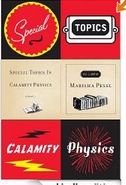 Don’t let the title fool you. Special Topics in Calamity Physics isn’t a science book. Marisha Pessl’s debut novel, published in 2007, is clever and quirky and I couldn’t stop turning the pages.
Don’t let the title fool you. Special Topics in Calamity Physics isn’t a science book. Marisha Pessl’s debut novel, published in 2007, is clever and quirky and I couldn’t stop turning the pages.
Blue Van Meer’s life has been anything but ordinary. Traveling the country with her professor father as he moves from one guest lecturer post to another has provided Blue with a thorough, if rather unconventional, education. However, like any teenager, she longs for roots and friends, and her father agrees to take a position that will allow Blue to attend St. Gallway’s School for the last part of her high school education.
At St. Gallway’s, Blue is suddenly and somewhat reluctantly thrust into a clique called the Bluebloods, spearheaded by eccentric drama teacher Hannah Schneider. But after a drowning and then a hanging, Blue finds herself in the middle of a murder mystery with ramifications far greater- and far more personal- than she ever imagined.
Not only does Special Topics In Calamity Physics tell an interesting story, it is told in an interesting way. Complete with sources referenced in parenthetical documentation, and with supporting illustrations and diagrams, Blue reveals her story almost as if it were an academic paper.
The characters don’t seem quite real- they are like the ultra rich, way too cool kids of movies like Cruel Intentions- a little surreal, a little more adult than my counterparts when I was that age. Their language is more adult, more academic and not full of teenaged slang. Yet the angst is very real, the chances they take, the games they play. And at the heart of it all is the enigmatic Hannah Schneider. Hannah has her own motivations for pulling together the Bluebloods and putting Blue in their midst, and as readers, we’re taken along for the ride as Blue figures out why.
As I mentioned, sources are well referenced in the book, and at times this was distracting. I wanted to know a bit more about the source, or else just wanted to skip over it to get to the next part of the story. However, the more I read, the less bothered I found myself. The illustrations and other visual aids did enhance the story, even on an ereader as opposed to the paperback.
I wanted the story to reveal itself faster. That’s not to say it was a slow read, just that I was that eager to find out the story and what happened. There’s a twist at the end, which I guessed just a few pages before it was revealed. However, figuring this out takes away nothing from the story. In fact, Pessl plants just enough clues that I’d be surprised if a number of folks didn’t guess the twist.
I think this book is a good candidate for book clubs- the characters, the style, the plot all leave plenty of room for discussion. Checking Amazon, it looks like this is the only book Pessl has published to date. I hope she writes more. I’d love to see a second novel from her.
- Tags: book club, calamity physics, fiction, Pressl